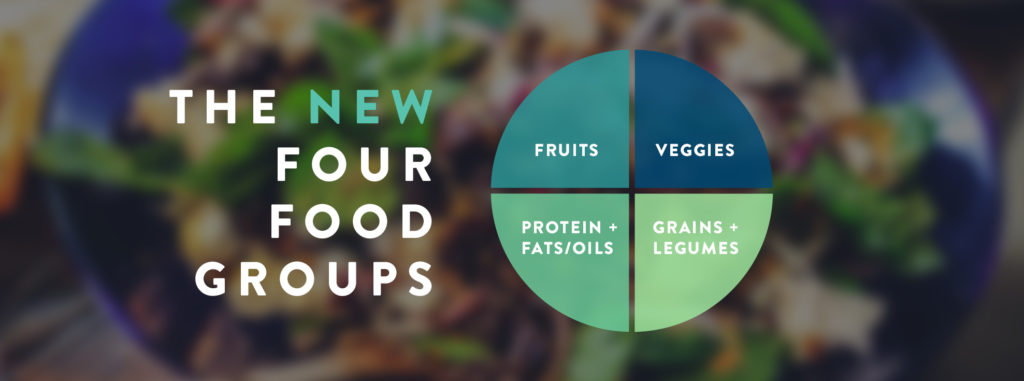
A Basic Outline For Healthy Eating
The idea of the basic four food groups that most of us grew up with is, sadly, as outdated as it is ridiculous, putting the most nourishing foods, fruits & vegetables, into a single category.
We’ve been taught to believe that these four categories are equally important, and that as long as we include each category in our meals we do not need to differentiate between ‘good’ and ‘bad’ foods in each, despite the fact that, according to the in the old food groups, french fries would be considered part of your ‘fruit and vegetables’ for the day, and a breakfast consisting of bacon, white bread, processed cheese, and hash browns would be considered healthy, or at least balanced, under the old four food groups.
While there are ways to make the old four food groups work to achieve a healthy diet, such as in a meal of wild salmon with quinoa and a spinach salad topped with a Cesar dressing, the bar here is still set too low and does not provide enough of a healthy framework for people who are unfamiliar with their own nutritional needs.

The Old Four Food Groups
1. Meats
Meat is not necessary for a healthy diet as there are plenty of plant-based foods that give us the amino acids we need. This requirement that meat, alone, should take up around 25% of our diet can also harmful for our bodies since too much protein (in any form) can be detrimental for our health. This isn’t to say you need to abstain from meat to be healthy; you can absolutely eat meat as long as your overall daily protein consumption isn’t too high (15% is ideal), and that you’re eating quality meat (organic, hormone-free, unprocessed).
2. Dairy Products
Dairy products are also narrowed into a single, illogical category that limits nutrients. We’re taught to eat dairy products because they have calcium, but the calcium in dairy products can be difficult for our bodies to absorb. Milk also loses a great deal of calcium during the pasteurization process; as well as most of the enzymes that are needed to obtain the calcium. Milk and dairy products are also a huge contributor to food allergies that can cause a range of health problems. For a healthy diet, it would be wise to minimize your overall dairy consumption. Fortunately, if you eat a healthy diet with plenty of fresh green vegetables, you will meet all your calcium requirements; whether or not you choose to eat dairy products.
3. Breads & Cereals
Listing an entire category as breads and cereals makes it seem as though bread and cereal, themselves, are healthy. Sadly, the majority of the time, breads and cereals are highly processed and, due to that processing, they retain only a small amount of the nutrients present in their original form. Instead, look at the original grains those breads and cereals are made from, then try to consume them in their least (or minimally) processed forms.
4. Fruits & Vegetables
Fruits and vegetables are so extraordinarily healthy for you and so packed with nutrients, but here we’re meant to shove them both together into only 25% of our diet? While some people do eat that way, it is not considered a healthy diet that is going to help their bodies in the long-run. The healthiest diets in the world are the ones that put a lot of emphasis on fruits and vegetables since they’re relatively low in calories and carry the majority of the nutrients your body needs for optimal health.
So what guide should we follow instead?
The New Four Food Groups
The book Staying Healthy With Nutrition suggests four new basic food groups that properly caters to our nutritional needs and gives a guideline for a proper balance of nutrients that still allows for most dietary restrictions. It opens up nutrients to a wider range of foods and puts emphasis on the most nourishing foods.
1. Fruits
Bananas, apples, grapes, kiwi, cantaloupe… the list goes on! Fruits are so packed with good stuff that they should absolutely be a major part of your daily diet; and why not? Fruit is delicious. Fruit juices do not count here, unless they are freshly made juices without additives. The freshest fruit is the best fruit.
2. Vegetables
Vegetables, you know… carrots, spinach, broccoli, celery, etc. They’re not as delicious as fruit (sorry veggies) but just as important. Vegetables should be eaten with every single meal of your day, or at least play a major part in where you get your calories each day. If you eat a high variety of vegetables, and eat a lot of them, your body will feel better and handle things better thanks to the proper nourishment you’re providing it.
3. Whole Grains & Legumes
This includes things like whole wheat, spelt, kamut, rice, quinoa, etc. This does not include things like highly processed white bread or sugary cereals, but allows for breads and cereals made from whole grains without chemicals or refined sugars. This category also includes legumes like beans, peas, soybeans, and lentils which did not really have a category before, but are so important to our health. Legumes contain more protein than any other plant-derived food and are packed with vital nutrients and fiber, thus they are pretty important in a properly balanced diet.
4. Proteins and fats/oils
This doesn’t just refer to meat and dairy anymore, so if you’re vegan or vegetarian the new four food groups will still work. This category includes nuts and seeds like almonds and sesame seeds, in addition to dairy products, eggs, fish, and meat, as well as oils.
To Conclude
The new four food groups are still open to interpretation. Thankfully, they leave less room for an unhealthy diet than the old four food groups. Eat a variety of different fruits, vegetables, nuts, seeds, and grains. Don’t tilt your diet too heavily in the direction of meat or dairy. Eat junk food in moderation only. Do those things and your diet will be balanced. Your body will thank you for it.
Sources
Elson Haas, Buck Levin. Staying Healthy with Nutrition.
New York: TenSpeed Press, 2006. Print.
Phyllis Balch, James Balch. Prescription for Dietary Wellness
Avery Pub. Group. 1998. Print
Nutritional Symptomatology.
Danielle Perrault. Ontario. CSNN Publishing, 2013. Print.







Leave a Comment